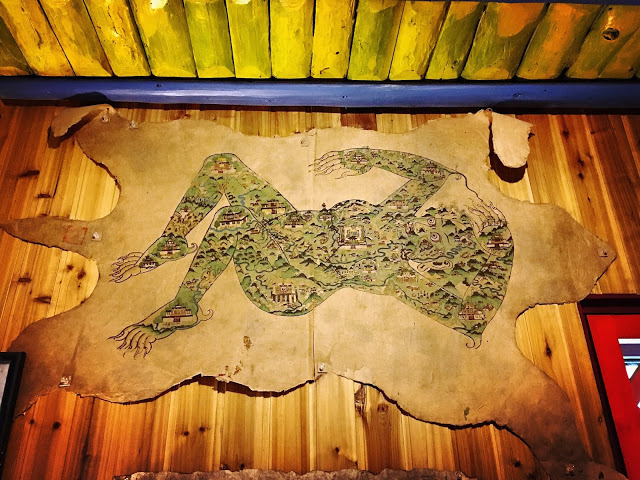
High Peaks Pure Earth has translated a blogpost by Woeser, originally written in March 2016 for the Mandarin service of Radio Free Asia and published on her blog on April 10, 2016.
In this piece, Woeser looks at the very first maps of Tibet drawn by Tibetans in the form of a supine demoness, senmo (srin mo). Fusing geography, geomancy and art, Woeser both looks back in history whilst also bringing the senmo right up to the present day.
For more on senmo through the lens of myth and gender, read the 1987 article “Down with the Demoness” by scholar Janet Gyatso as well as a more recent close reading of the text on exile blog Lhakar Diaries.
Editor’s Note: This post experienced delays in going up due to the exceptional volume of place names that were difficult to transcribe correctly. Thank you to all those who helped. If any mistakes exist or corrections need to be made, please contact us, thank you!
“The Senmo Map, or the Resurrection of the Demoness”
By Woeser
1.
There is a book claiming that the Senmo painting was the first map of Tibet drawn by Tibetans themselves.
According to Tibetologists, this map reflects Tibetan people’s own territorial understanding.
At first glance, it looks more like the portrait of a woman than a map. But it is quite natural for an ancient civilisation to turn a map into a painting with a story. Researchers say: “In ancient Tibet, maps were ‘expressionistic’ illustrations and a display of important symbols; compared to strict topographical maps, Tibetan maps managed to convey and narrate many spiritual and cultural elements and added a great deal of religious and divine meanings.”
Every single detail on this map has a profound meaning. The Tibetan scholar Wangchuk Deden Shakabpa explained in his book “Tibet: A Political History”: “According to a prophecy from a tutelary deity, the Tadül, Yangdül, and Runön Tsuklakhang temples were constructed (by Songtsen Gampo), including Tradruk Trashi Jamnyom Temple.” Already the senior monk Jamyang Khyentsé Wangpo said in records of a pilgrimage that Songtsen Gampo “following the advice of a geomancy master, travelled to Tradruk Trashi Jamnyom Temple to hold down the demoness’ left shoulder.”
Even earlier, in the biography of the fifth Dalai Lama it is stated that “he restored the Tadül and Yangdül temples as a place for peace and happiness for lay people; he also gave Sera and Drepung monasteries a golden roof and a Buddha statue, built a new scripture hall, drew murals on the walls of Reting Monastery and undertook various other works, all in accordance with the contents recorded on the manuscripts that had long been forgotten.”
The French Tibetologist Rolf Stein provides relatively detailed explanations of this Tibetan map in his book “Tibetan Civilization”: “The lake in the Plain of Milk where the first Buddhist King built his temple represented the heart of a she-demon lying on her back. The she-demon is Tibet itself, which had to be tamed before it could be inhabited and civilised. Her body already covered the whole extent of Tibet in its period of military greatness (eighth and ninth century). Her outspread limbs reached to the present boundaries of Tibetan settlement … Temples erected at the four corners of three successive squares stand for nails driven, as it were, into the limbs of the demoness, crucifying her. The land is held firm and made fit for habitation. ‘To keep the limbs of the prostrate she-demon under control, twelve nails of immobility were driven into her,’ says a chronicle of 1508, before listing the thrice four temples that were built.”
The book “The Lhasa Atlas: Traditional Tibetan Architecture and Townscape”, by two Norwegian authors, also describes: “Myths and beliefs from the time of King Songtsen Gampo (7th century) describe a pre-Buddhist ‘demoness’ hostile to Buddhism. She is lying on her back covering all of Tibet. Songtsen Gampo is said to have started building 108 temples throughout the country, from Lhasa to the frontiers of his empire, to pin down vital body parts – shoulders, hips, elbows, knees, hands, feet – in order to tame the demons. The strategically placed temples emanated outwards from the centre in a series of concentric zones; the Jokhang was the central temple, placed above her heart. The first ‘maps’ of Tibet were possibly of this geomantic type.”
2.
The above-mentioned demoness is referred to as “she-demon” (“罗刹女”), or senmo (srin mo སྲིན་མོ) in Tibetan. The word for demon is Sanskrit and first appeared in the ancient Indian classic Rigveda. According to the Chinese Buddhist text “Hui Lin Yinyi”, China also has Buddhist texts recording that “It was called “demon” in the past, which was the mispronounced abbreviation of Rākṣasa in Hindi. The male rakshasa is very ugly, while the females are quite beautiful. But both ate human beings.” There are many rākasī (female Rākṣasa or she-demons) recorded in Buddhist scriptures: the so-called top eight rākasī, top ten rākasī, the 72 rākasī, the 500 rākasī, and so on. But both genders of the demon have the potential of transforming into the protection deity Nairriti. Nairriti is one of the twelve deities who promises to protect and teach proper Dharma.
The drawing showing this demoness was included in the “Geomantic Table for the Supine Rākasī” collected by the Kashag, the Tibetan cabinet. In the memoirs of Lhasa aristocrat Shatra Ganden Paljor, it is stated: “… for political and religious peace, according to the prayers against disaster in the Kashag’s “Geomantic Table for the Supine Rākasī”, (they) chanted prayers for Mahesvara in the ‘temples holding down the demoness’ limbs’, such as the Gephel Utse Ri located in the outskirts of Lhasa, Jomo Silser Ri, Chagsam Chubo Ri, and in Samye Monastery on Mount Hebu in Lhokha. They offered incense at these sacred mountains that protected all lives in Tibet; they hung up prayer flags and offered sacrifices to all the deities who protected Dharma and upheld good karma.”
I have unfortunately not seen this collection myself. But there are many copies of this map, all claiming to originate from one or two thangkas. The thangkas were originally kept in the summer palace of His Holiness, at Norbulingka, and are now an important item of the Cultural Heritage Committee of the Tibet Autonomous Region, being exhibited at various exhibitions and sometimes serving as a proof that “Tibet has always been part of China”. Some say that they have already been moved to the Tibet Museum, but I am not sure if these are really the original pieces. According to various explanations, the two thangkas are of the same size, 152.5 cm high and 72 cm wide; both show the demoness with 12 geomantic temples at all important points of her body, called the “twelve immutable nails.”
3.
I am not sure whose civilisation’s tradition tells us to use geomancy to know that when there is a demon we need to build a temple.
I think it might come from the indigenous Tibetan religion, Bon. In the 7th century, when Buddhism entered the Snowland, but had not yet taken any roots, the Bon religion had already existed for hundreds of years. Using a rather simplistic and imprecise explanation, according to the Bon belief, all living things are also spirits. Geomancy is called “sashu” in Tibetan, an ancient word originating from the Bon religion.
Are there any theories about building monasteries in order to hold down demons in India, the birthplace of Buddhism? It is said that geomancy is very important in India. It is called Vastu, a word originating from the Sanskrit term Vas, which means “to reside”. Indian geomancy masters believe that 80% of a person’s good or bad luck comes from his or her residence and living environment, which is why the position of a building is of great importance. What is interesting is that a building’s area conforms with the shape of a human being, as mentioned in a legend in the Rigveda, so it basically assumes the shape of a human body. And it is possibly a shape of a spirit or demon. So it very much resembles the Tibetan Senmo map.
Have the building of monasteries and temples in China been related to the holding down of demons? The ignorant me has unfortunately not been able to find any related information or explanations. It seems that in Chinese culture, people are more concerned as to whether the so-called “feng shui” is good for one’s living environment or Buddhist practice. Just as it is said in the “Mahavairocana Tantra”: “If he receives instruction steadfastly, he should select a plain ground. There may be many flowers and fruits in the mountainous forests and there may be very agreeable pure fountains. Such are applauded by many Buddhas.” I think it is difficult to relate the Senmo map to Chinese culture.
It is even greater nonsense to do what is often done today, namely to relate the map to Princess Wencheng. During the Tang Dynasty, Princess Wencheng pretended to be an aristocratic daughter. For political reasons, she was forced to marry Songsten Gampo at the age of 16 and embarked upon a long journey to the remote Lhasa. Even though she was an exceptionally talented young woman and even though she used every moment of the long and tough journey to learn everything from astrology to geography, we cannot regard her as a fairy descended onto earth and we cannot regard her us a geomancy expert either. It is simply not possible, as people have been claiming, that she miraculously “managed to understand Tibetan topography and the demoness’ shape simply by relying on geomancy reference books”.
With regards to the narrative of how the geography, history and culture of Lhasa and the whole of Tibet has come about, the powerful discourse of today’s autocrats have placed the burden of being responsible for the big task of national unification on the shoulders of an ancient Chinese woman. In the unquestionably and undoubtedly constructed narratives, she possesses an even greater magical power than the famous Sun Wu Kong in the Chinese literary classic the Monkey King. She is omnipotent and there is literally nothing that she was not capable of doing, everyone just relied on her: she civilised Tibet, she knew geomancy, and she even taught Tibetans how to paint thangkas.
For various different reasons, this young lady has been deified to the point that she was no longer a human being.
4.
In order to explain why monasteries and temples were built to hold down demons requires attention to detail, this is what Tibetans themselves state. The monasteries that were built include: the temples holding down her legs, those holding down her joints and those holding down her hands and feet.
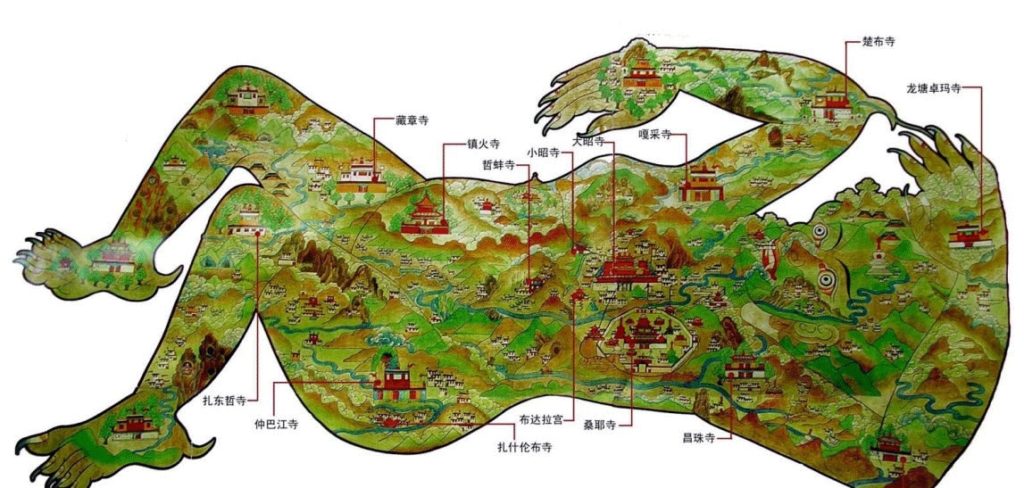
But let us first talk about the temple holding down her heart. I call it a temple, but we should call it a Buddhist hall, because the Jokhang Temple is not a monastery, but a hall for the veneration of the statue of Jowo. It was built exactly where the demoness’ heart is located. The Chinese Princess Wencheng who carried the statue of the 12-year-old Buddha worshipped at the Jokhang first and Ramoche second. Bhrikuti, the Nepalese queen and earlier wife of Songtsen Gampo who brought along a statue of the 8-year-old Buddha worshipped at Ramoche first and at the Jokhang second.
Temples holding down the limbs: There are four in total, holding down her shoulders and feet.
- Trandruk Temple: Built on the demoness’ left shoulder. Situated in today’s Lhokha Prefecture, Nedong County, Trandruk District, on the eastern side of the river Yarlung. It was destroyed during the Cultural Revolution and later rebuilt, but is inferior compared to the original.
- Katsel Temple: Built on the demoness’ right shoulder. Situated where Zhorong River and Machu River join to the east of Meldro Gungkar County. It was destroyed during the Cultural Revolution and later rebuilt, but is inferior compared to the original.
- Drongpa Temple: Built on the demoness’ left foot. Situated in today’s Lhatse County, Shigatse Prefecture, to the east of the river Yarlung. It was destroyed during the Cultural Revolution and later rebuilt, but is inferior compared to the original.
- Zangchang Temple: Built on the demoness’ right foot. Situated in today’s south-eastern Topgyel area, in Shigatse Prefecture, north of the river Yarlung. It was destroyed during the Cultural Revolution and later rebuilt, but is inferior compared to the original.
Temples holding down the joints. There also four main temples holding down the demoness’ joints.
- Lhodrak Khothing temple: Built on the demoness’ left elbow. Situated where the Sharchu river and Nubchu river join, in today’s south-eastern Lhodrak County, just to the north of Bhutan. It was destroyed during the Cultural Revolution and later rebuilt, but is inferior compared to the original.
- Kongpo Buchu Temple: Built on the demoness’ right elbow. Situated in today’s Buchu District, in Nyingtri County. It collapsed during the massive earthquake during the 1930s, but was ordered to be restored. It was destroyed during the Cultural Revolution and later rebuilt, but is inferior compared to the original.
- Traduntse Temple: Built on the demoness’ left knee. Situated in Tradun, in today’s Drongpa County, Shigatse area. It was destroyed during the Cultural Revolution and later rebuilt, but is inferior compared to the original.
- Rongjamchen Temple: Built on the demoness’ right knee. Situated near the border, in today’s southern Kyirong County, Shigatse area. It was destroyed during the Cultural Revolution and later rebuilt, but is inferior compared to the original.
Temples holding down the demoness’ hands.
- Kham Langtang Dolma Lhakhang: Built on the demoness’ left hand. Situated in today’s Sershul County, Kardze Tibetan Autonomous Prefecture, Sichuan Province. It was destroyed either in 1958 or during the Cultural Revolution and later rebuilt, but inferior compared to the original.
- Bumthang Kyerchu Temple: Built on the demoness’ right hand. Bumthang is a place in central Bhutan. Kyerchu is the name of a river, flowing out from the western parts of Lhodrak, past the Monla Karchung mountains in the southern corner of Lhodrak, and into Bhutan. This temple should still be standing today.
- Tsalrig Sherab Dolma Temple: Built on the demoness’ left foot palm. Situated inside today’s Ladakh area, India, but was originally under Tibetan jurisdiction. This temple should still be standing today.
- Tsangpa Lungnon Temple. Built on the demoness’ right foot palm. Situated on the northern Tibetan grasslands; but its exact position remains unknown. It was destroyed during the Cultural Revolution. I am not sure whether it has been rebuilt.
Subsequently, more temples to hold down the demoness’ limbs were built across Tibet, a total of 108. In addition, many pagodas, stone lions, Maheśvaras, rocs, white snail shells etc. were built for good fengshui to drive away the evil spirits.
5.
But temples did not only have this one meaning of holding down demons. They signify other things.
For example, the eight auspicious symbols. According to A History of Tibet by the Fifth Dalai Lama, “the east is shaped like a raised lamp; the south is shaped like a stupa; the west is shaped like spiralled trophy placed on a round altar; the north is shaped like a blooming lotus flower. There are also four sacred mountains; out of the surrounding mountain range, the Pengjia mountain is shaped like the white umbrella, Meldrong mountain like the golden fish, Dongkar mountain like the lotus flower, with the ice on its shadow side looking like the right-turning white shell, Jongtsen mountain like the treasure vase, Yugba mountain like the mystical knot, Penkar mountain like the victory banner, and Drangphu mountain like the dharma wheel, altogether combining the eight auspicious symbols.
“Moreover, Chagga mountain, the Shugpa mountain ridge, the Rakhag mountain rock, Jumuser mountain are gold, silver, copper, and iron, combining the four precious minerals. Then there are the Tagga Gonghoma in the east, the Yudrug Tsangchab in the south, the Chade Budong in the west, and the Rupal Bongkha in the north.”
6.
For the time being, let’s call the drawing the Senmo map, even if such popular expressions always feel a little bit vulgar.
We already know that the painting was produced in the 7th century, perhaps even earlier. On what material was the original painted? On animal skin or Tibetan paper? Paper would not have lasted very long, even if it had been made from very solid rhizome, as it is sensitive to touch. If the painting had crumbled and the lines not been clear anymore, it would have been an unforgivable mistake, because it represented the territory of a nation. Even though at the time, the sense of territory and borders was not as clear as today, the overall appearance and manifestation of a territory had to still be negotiated.
This is why the Senmo map must have first been painted on animal skin, for example on rare tiger or leopard skin; or perhaps on the more common yak or sheepskin. It is more unlikely to have been painted on cat or mouse skin, as these are too small; the large territory would not have fitted. I hope that it was painted on sheepskin, which does not mean that I am particularly interested in skinning sheep. But sheepskin scrolls or books have always given me a feeling of going back in time, a feeling and flavour of softness and innocence.
Sheepskin is soft and easy to roll; painting the Senmo map on sheepskin would have allowed those horsemen galloping fast across the territory to carry it along like a sword on their shoulders; it would have allowed monks to carry it on their backs like a thangka; the map thus became a practical tool for travel, showing people the borders, the distances and positions of monasteries.
The map only included monasteries, no residences or governmental buildings; but monasteries could be understood as the key landmarks of the whole Tibetan territory.
Tibet serves as a perfect example for building activity that is in complete accordance with local circumstances. Residential houses, for example, grew out of the soil, and religious places located high up were built in accordance with the mountain shape, signifying different ranks. Other monasteries built half way down the mountain or on the plains also existed in harmony with their natural surroundings. Temples on the plains were in a sense more like divine cattle tents where nomads kept their yaks, but they were essentially a manifestation of sand mandalas.
Gradually, that map was officially repainted on thangkas. According to drawing techniques during the time of the Fifth Dalai Lama, they used gold, silver, cornelian, coral, pearl and other mineral pigments as well as saffron, rubia cordifolia, rhubarb and other plant pigments. They mounted the painting on a precious silk cloth and painted the “supine demoness”. Were they painted by the talented Regent Sangye Gyatso? I am not sure.
7.
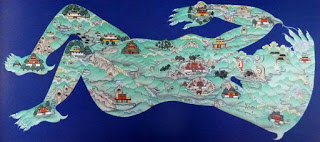
The many Senmo maps produced today with different kinds of materials are evidently forgeries. We all know about forgeries and also, many of the original details have simply been ignored in these reproductions. But there is one forgery that appears to be very unique. The painter’s name is Penba Wangdu, from Shigatse; he is in his forties and professor at the art institute of Tibet University. At an exhibition about contemporary Tibetan art in 2010 at the Songzhuang Art Centre in Beijing, he was among the 50 Tibetan artists whose works were displayed. His exhibited a triptych centred on the Senmo map. The first one used blue as the foundation, the second one white and the third one red (see photos). Through the change of colour and adding or taking away of buildings, he managed to convey the changes in Tibetan geography and life in a subtle way, depicting a kind of loss and alienation.
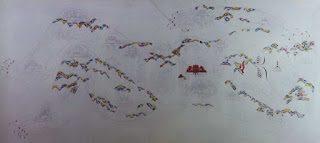
A few years ago, I was at a special needs school near the Lhalu wetlands and purchased a copy of a Senmo map for 900 Yuan. It had been clumsily copied onto a crude piece of Tibetan paper cut into the shape of an animal skin. I put the roll into my suitcase and when I got back to Beijing, hung it on my wall. Once, a female journalist from the Associated Press who had come by to interview me, took notice of it. She felt uneasy about the fact that a woman was being held down on this map, why wasn’t it a man? Seeing this appealing lady being regarded as a demon and pinned down for hundreds of thousands of years appeared to be an embodiment of colonialism. This is what the journalist explained to me, feeling quite emotional. I had to laugh, her idea of “the other” was indeed very interesting.
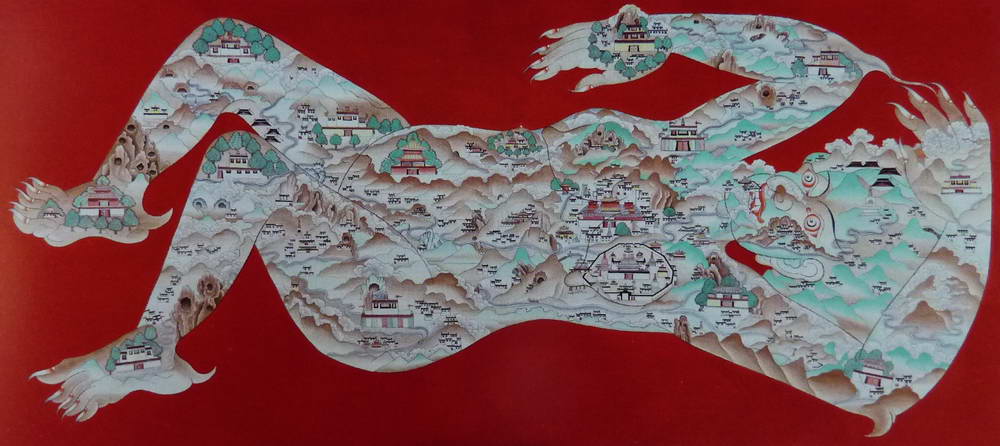
Online, I came across a Chinese netizen who used the eight divinatory diagrams of “The Book of Changes” to discuss mathematics in geomancy. I generally agree with his point. He said that “holding down” is a method used against demons. This method will generate instant results, but when the temple to “hold down” the evil is destroyed, the “qi” of the evil will no longer be held down. Doesn’t this mean that the demon lives on even stronger?
So, whether there were 12 temples (nails) or 108 temples (nails), since 1950 and especially during the catastrophic Cultural Revolution after 1966, almost everything has been drowned in disaster, almost everything has sunk into ruins. And doesn’t this mean that the original nails holding down the demoness have been lifted and the demoness has struggled back to life to once again cause mischief? Even though many monasteries were rebuilt after the Cultural Revolution, the magical power is inferior to before. So who holds the power of the released demoness? The self-appointed “saviours” and “liberators” came uninvited and those liberated were not the millions of Tibetans, but the demoness in the body of a pretty woman.
I am reminded of a poem by the British poet T.S. Eliot. “The Hollow Men” begins like this:
We are the hollow men
We are the stuffed men
Leaning together
Headpiece filled with straw. Alas!
Our dried voices, when
We whisper together
Are quiet and meaningless
As wind in dry grass
Or rats’ feet over broken glass
In our dry cellar
Shape without form, shade without colour,
Paralysed force, gesture without motion;
March 2016


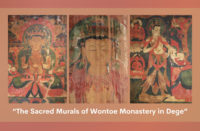
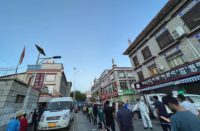
Fascinating read… Thank you.
I remember being told the world is on a giant tortoises flipped upside down (སྲིད་པ་འཁོར་ལོ)where the tortoises’ hand and legs are, is where you get earthquakes as it tries to move every now then. Therefore it might be an idea to check these places where temples are built to see if places where prone to earthquakes etc?